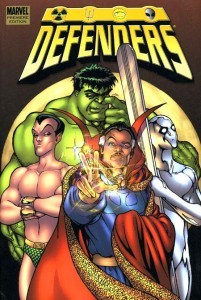Daniel Sherrier's Blog, page 33
August 21, 2016
Today’s Super Comic — The Amazing Spider-Man #262 (1985)
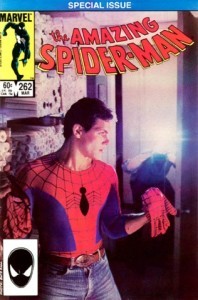 Well, of all the darn luck. Spidey’s just going about his usual routine of switching back to his civilian clothes in an airport closet, and in walks the most unethical photographer ever…with his camera ready. And of course the guy slips away because Spider-Man prioritizes helping people in need over catching the man who’s carrying negatives of Peter Parker’s face.
Well, of all the darn luck. Spidey’s just going about his usual routine of switching back to his civilian clothes in an airport closet, and in walks the most unethical photographer ever…with his camera ready. And of course the guy slips away because Spider-Man prioritizes helping people in need over catching the man who’s carrying negatives of Peter Parker’s face.
It’s a great Spider-Man scenario, and it plays out in a single issue. I’m not sure why the cover calls this a “Special Issue,” but it’s good stuff throughout, featuring a consistently in-character Spider-Man who needs to figure out how far he’s willing to go to preserve his secret identity.
With a solid script and pencils by Bob Layton, The Amazing Spider-Man #262 is classic ‘80s Spidey done right. And the cover is a nice change of pace, too.
Writer/Artist: Bob Layton
Publisher: Marvel Comics
How to Read It: back issues; Marvel Unlimited; Comixology
Appropriate For: ages 9 and up
August 20, 2016
Today’s Super Comic — Great Zombies in History #1 (2011)
 Full disclosure—I’m a little biased with this one. My uncle, Joe Sergi, contributed to this project, but he didn’t write anything in this particular issue. In any case, it’s Great Zombies in History. The concept is objectively great.
Full disclosure—I’m a little biased with this one. My uncle, Joe Sergi, contributed to this project, but he didn’t write anything in this particular issue. In any case, it’s Great Zombies in History. The concept is objectively great.
The zombie subgenre isn’t the most versatile one. Slothful, rotting, cannibalistic dead people pose a credible threat only in large and growing numbers. They’re apocalypse fodder, basically. So they’ve appeared most frequently in end-of-civilization scenarios. How to shake things up? Go back in time. Pepper them throughout history.
It’s a superb premise for an anthology book. It allows up-and-coming creators a chance to show their skills in the historical setting of their choice, and readers get a variety of short stories that are historically accurate except for the inclusion of zombies. It’s like you get to travel in the TARDIS, but it’s fixated on zombies for some weird reason.
Premise aside, is the execution fun? Of course.
The first issue features three stories, and they inject zombies into Feudal Japan, the Battle of Thermopylae, and Jack the Ripper, respectively. Each writer/artist team latches onto the zombie concept in their own unique way, so you never know quite what you’re going to get as you turn the pages…other than zombies and history, of course.
The original issues were independently produced, but McFarland published the trade paperback collection. It’s well worth tracking down for a fresh take on rotting animated corpses. But again, I’m biased, so you’ll just have to check it out for yourself.
Writers: Eric Drumm, Rob Anderson, Joshua Osborne
Artists: Leandro Panganiban, DaFu Yu, Randy Valiente
Publisher: Elevator Pitch Press (TPB publisher: McFarland)
How to Read It: back issues; included in Great Zombies in History (TPB)
Appropriate For: ADULTS ONLY
August 19, 2016
Today’s Super Comics — Age of Ultron #1-10 (2013)
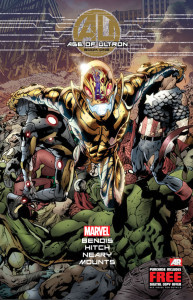 I finally got around to reading the miniseries from which the last Avengers movie took its name, and yeah, other than the title and threat of Ultron, not much in the way of similarities.
I finally got around to reading the miniseries from which the last Avengers movie took its name, and yeah, other than the title and threat of Ultron, not much in the way of similarities.
Age of Ultron the comic begins as a post-apocalyptic tale featuring several Marvel superheroes striving to do whatever they can for a world that’s already ended. And it shifts gears into a time-travel adventure starring the odd-couple pairing of Wolverine and the Invisible Woman (a brilliant pairing, as they’re total opposites in so many ways—shame there wasn’t more time to spend with them). And it somehow winds up being a story about the importance of one deeply flawed man—Ultron’s creator, Hank Pym.
And even with the time-travel shenanigans and the inevitable reset to undo the apocalypse, events have consequences for the present-day Marvel Universe.
It’s not the movie, but it does feel like a big-budget superhero film in comic book form, with lots of favorite characters (and alternate versions of such) each getting time to shine. Nowhere near perfect, like the movie, but it’s lots of fun regardless, also like the movie. (So maybe there are more similarities.)
Different artists contributed over the course of the series, but the differences in their styles feel appropriate, never jarring. Bryan Hitch sets the tone in the first half—the man draws a great apocalypse. And, of course, Brian Michael Bendis wrote the entire series, and at this point I’m convinced he’s a comic book savant.
Writer: Brian Michael Bendis
Artists: Bryan Hitch, Brandon Peterson, Carlos Pacheco
Publisher: Marvel Comics
How to Read It: back issues; Marvel Unlimited; Comixology; Age of Ultron (TPB)
Appropriate For: ages 14 and up
August 18, 2016
Today’s Super Comic — Uncanny X-Men #161 (1982)
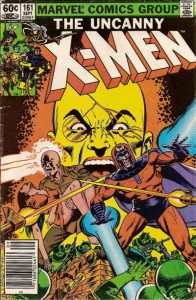 Comic book mythologies are often created on the fly, particularly those involving the classic superheroes. It’s a fun, if also perilous, aspect of the medium. A writer and artist will introduce the core concept, and over the years other writers and artists will build on the established canon, making connections and finding opportunities their predecessors hadn’t thought of. Superman, Batman, Spider-Man, etc.—none were introduced with any grand multi-year plan in mind.
Comic book mythologies are often created on the fly, particularly those involving the classic superheroes. It’s a fun, if also perilous, aspect of the medium. A writer and artist will introduce the core concept, and over the years other writers and artists will build on the established canon, making connections and finding opportunities their predecessors hadn’t thought of. Superman, Batman, Spider-Man, etc.—none were introduced with any grand multi-year plan in mind.
The X-Men movies have gotten lots of mileage out of the past friendship between Professor Xavier and Magneto, which for many years has been an essential component of X-Men comic book continuity. But not all the years.
Magneto debuted as standard-issue raving super-villain bent on humanity’s destruction. He had neither backstory nor nuance in 1963, and certainly no previous ties to Xavier.
Even as late as Uncanny X-Men #149, Xavier was recapping the X-Men’s battles with Magneto as if the man was some stranger of mysterious origins. But by #161, writer Chris Claremont figured out that a past friendship between the X-Men’s leader and most persistent foe would add much-needed depth to the villain. And he was right. It was a brilliant move, and worth ignoring any contradictions in previously established continuity.
In #161, Xavier flashes back to twenty years earlier, when he meets a Holocaust survivor named Magnus who’s volunteering in an Israeli hospital. They become friends as they work together helping a patient, Gabrielle Haller (this is also the first time we meet the mother of Xavier’s son, David Haller a.k.a. Legion, though he was still a few years away from his debut—another example of retroactively building continuity).
It’s a solid issue, complete with young Xavier and Magneto teaming up to battle Baron Strucker and Hydra, but most interesting is watching the beginning of the ideological divide between the two, which would be revisited and fleshed out in multiple mediums over the next few decades.
Magneto would be many things in the years to follow—antagonist, head of Xavier’s School, brain-dead focal point of a cult, depowered former mutant, repowered mutant, subordinate to Cyclops, and so on—but he was never a standard-issue raving super-villain again.
Writer: Chris Claremont
Penciler: Dave Cockrum
Inker: Bob Wiacek
Publisher: Marvel Comics
How to Read It: back issues; Marvel Unlimited; Comixology; included in Essential X-Men vol. 3 (TPB)
Appropriate For: ages 10 and up
August 17, 2016
Today’s Super Comic — Fantastic Four #60 (2002)
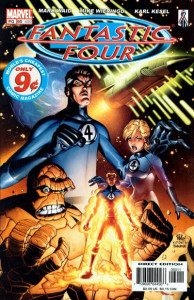 The movies don’t do the Fantastic Four justice, which is a shame because when done right the concept facilitates pure, unbridled fun.
The movies don’t do the Fantastic Four justice, which is a shame because when done right the concept facilitates pure, unbridled fun.
Writer Mark Waid and artist Mike Wieringo kicked off an exceptional run on Fantastic Four with a promotional 9-cent issue that encapsulates what makes the FF great. It reads almost like a mission statement, though it’s done in a thoroughly entertaining manner.
Reed Richards hires a PR firm to reinvigorate the FF’s celebrity brand…which is of course odd that he would care about such a thing, thereby providing interesting subtext to the issue. So a publicist shadows the FF for a week, observing not only their wild adventures, but also how they relate to each other as a family. And the publicist learns what the real-world movie producers apparently never did.
The Fantastic Four aren’t actually superheroes, not primarily. They’re explorers who pioneer the unknown and chart the new. Reed’s scientific genius will result in the discovery of a new dimension, and his family will have his back as he explores it, hoping to glean new knowledge that can help build a better tomorrow. And the adventures are frequently crazy and colorful, and always starring four people who care a great deal about each other (even despite tendencies to bicker). This issue glimpses several wild situations, whetting the reader’s appetite for the fun to follow in subsequent stories.
And at the end, the reveal about why Reed would care about his family’s celebrity status shows a perfect understanding of the character.
Judge the FF on this, not the movies.
Writer: Mark Waid
Penciler: Mike Wieringo
Inker: Karl Kesel
Publisher: Marvel Comics
How to Read It: back issues; Marvel Unlimited; Comixology; included in Fantastic Four by Waid & Wieringo Ultimate Collection, Book 1 (TPB)
Appropriate For: ages 9 and up
August 16, 2016
Today’s Super Comic — Human Target #1 (2003)
 In the category of “I forgot I had this” …
In the category of “I forgot I had this” …
The Human Target is a high-concept character that’s been around since the ‘70s. Christopher Chance is an exceptionally talented man who impersonates his endangered clients to serve as their decoys. A master-of-disguise, man-of-many-faces sort of thing, but with a strong action bent. And his talents truly are talents, not superpowers. It’s a great concept for either comics or television, and it’s been used in both mediums.
The concept proved to be an excellent fit for DC Comics’ Vertigo imprint, the company’s R-rated line that tends to focus on more mature themes. Writer Peter Milligan re-envisioned the character as a man who’s losing his own sense of identity as his job constantly requires him to become someone else, and it’s a fascinating approach that adds existential depth to the action and intrigue.
After a couple of miniseries, DC/Vertigo promoted Milligan’s Human Target to an ongoing series, and its first issue works wonderfully as a pilot. It’s accessible in the sense that the reader requires no expository recap to get into the story, but it wisely withholds information about what’s going on, allowing the issue to build to a twisty finale that sets the tone for the series.
Very intelligently handled, and still worth a look over a decade later.
Writer: Peter Milligan
Artist: Javier Pulido
Publisher: DC Comics/Vertigo
How to Read It: back issues; Comixology; included in Human Target vol. 1: Strike Zones (TPB)
Appropriate For: ADULTS ONLY
August 15, 2016
Today’s Super Comics — Action Comics #26-29 (2014)
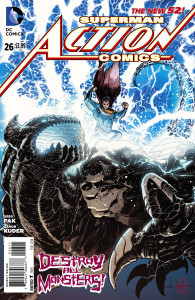 I confess, I haven’t been a fan of DC’s New 52 reboot. But for all its disappointments, I’ve found some gems along the way. And one of my favorites is Greg Pak’s excellent run on Action Comics, and its MVP isn’t Superman…it’s Lana Lang.
I confess, I haven’t been a fan of DC’s New 52 reboot. But for all its disappointments, I’ve found some gems along the way. And one of my favorites is Greg Pak’s excellent run on Action Comics, and its MVP isn’t Superman…it’s Lana Lang.
Recent depictions of Superman (the Zack Snyder movies in particular) have portrayed him as far too god-like and terrifying, which really misses the point. But Pak found the perfect way to humanize the New 52 Superman—have him reconnect with a childhood friend.
This storyline shows the correct way to reboot a character. By making her an electrical engineer, Pak gives Lana a professional life and useful skills she had always lacked. But he retains the essence that made the character work previously—Lana is one of very few people who sees right through the big red S because she knew him when. If he’s in costume but no one else is around, she’ll call him “Clark,” because why wouldn’t she? And on top of all that, she’s downright likeable.
Pak also succeeds with Superman’s characterization, presenting him as a guy who befriends monsters because he takes the time to figure out which ones aren’t actually monsters. That’s a very Superman thing to do.
All in all, this is an enjoyable tale of two old friends reconnecting…in an exotic subterranean landscape filled with dangerous creatures.
Definitely a standout among recent Superman stories.
Writer: Greg Pak
Penciler: Aaron Kuder
Publisher: DC Comics
How to Read It: back issues; Comixology; included in Action Comics vol. 5: What Lies Beneath (TPB)
Appropriate For: ages 10 and up
August 14, 2016
Today’s Super Comic — Daredevil #223 (1985)
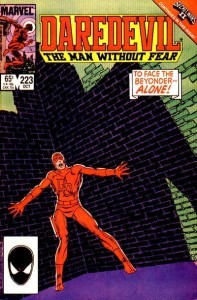 Ironically and impressively, Daredevil #223 ties into a company-wide crossover and stands on its own as a superb done-in-one story.
Ironically and impressively, Daredevil #223 ties into a company-wide crossover and stands on its own as a superb done-in-one story.
Secret Wars II was a mixed bag on the whole. The main premise involved the omnipotent Beyonder visiting Earth to learn about humanity. And being all-powerful, he could pop into a seemingly limitless number of Marvel titles throughout 1985.
The Daredevil tie-in gets the reader up to speed in a single page, wasting no time with any irrelevant details. The Beyonder had used his god-like powers to conquer the world, but that proved unsatisfactory. So now he wants to take over the world legally. Step one: employing the services of Nelson & Murdock, Attorneys at Law. And he pays Matt an invaluable retainer—the restoration of his sight while leaving his other super-senses intact.
So Matt enjoys one amazing day taking in the sights of New York City with his girlfriend Gloria, and the experience leads to a decision that reminds us what an incredibly ethical character Daredevil is (well, other than the whole secret identity thing, of course). The man holds himself up to high standards, as a superhero should.
A great quick read that holds up remarkably well, even despite being saddled with a crossover.
Writers: Denny O’Neil and Jim Shooter
Penciler: David Mazzuchelli
Inker: Kim DeMulder
Publisher: Marvel Comics
How to Read It: back issues; Marvel Unlimited; Comixology
Appropriate For: ages 10 and up
August 13, 2016
Today’s Super Comics — Defenders #1-5 (2005)
The same creative team that brought humor to the Justice League (see yesterday’s review) performed an encore of sorts with Marvel’s Defenders.
The Defenders debuted back in the 1970s, teaming up powerful loners Doctor Strange, Namor the Sub-Mariner, the Hulk, and later the Silver Surfer. It ran for a respectable length but didn’t last. Might have fared better if anyone had realized the group’s tremendous comedic potential.
Doctor Strange is absurdly melodramatic. Namor is impossibly arrogant. The Silver Surfer is ridiculously philosophical. And the Hulk is the Hulk. Why did this take decades to figure out?
Anyway, Giffen, DeMatteis, and Maguire have loads of fun letting these characters be the most cartoonish versions of themselves and letting them bicker accordingly, but they don’t neglect the important rule they followed during their Justice League International tenure—we can have our fun, but the threats still need to be serious. In this case, the dreaded Dormammu and his sister, Umar, attain god-like power and rewrite reality. So just a little something for the fellas to sort out.
Well, not the Silver Surfer. He declines Doctor Strange’s invitation so that he may commune with others who “ride the board.”
The Silver Surfer hangs out with surfer dudes. Defenders nailed it.
Writers: Keith Giffen and J.M. DeMatteis
Penciler: Kevin Maguire
Publisher: Marvel Comics
How to Read It: back issues; Marvel Unlimited; Comixology; collected in Defenders: Indefensible (TPB)
Appropriate For: ages 13 and up
August 12, 2016
Today’s Super Comic — Justice League #1 (1987)
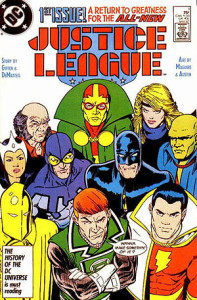 Let’s continue this streak of comical comic books, shall we? The next obvious place to turn is the “funny” incarnation of the Justice League.
Let’s continue this streak of comical comic books, shall we? The next obvious place to turn is the “funny” incarnation of the Justice League.
DC Comics rebooted the JLA franchise in the late ‘80s by giving it a more lighthearted, quirkier tone while keeping the threats serious. Comedy sprang from the characters’ colorful personalities, resulting in a frequently amusing, if seldom laugh-out-loud, series. Some storylines were sillier than others. A few were downright farcical. But as written by Keith Giffen and J.M. DeMatteis and drawn by Kevin Maguire, it remained a consistently entertaining book for about five years or so.
Looking back at Justice League #1 (before it rebranded as Justice League International shortly later), the creators seemed to ease into the new tone. Guy Gardner’s immaturity causes squabbling, and Batman gets to be the adult in the room (one who could stand to brush up on his people skills). But the main action of a terrorist siege at the United Nations is played fairly straight, and the book even includes a somber moment as the Martian Manhunter silently reflects on the downfall of the previous Justice League team he was a part of.
Still, it’s a clear shift from the traditional Justice League of America that was often staffed by consummate professionals. Issue #1 introduces us to a team whose individual members are formidable, but they don’t gel as amiably as their predecessors did. And that kind of friction serves the reader well.
It’s a more character-driven Justice League than in the good ol’ days…and yeah, a bit funnier, too.
Writers: Keith Giffen and J.M. DeMatteis
Penciler: Kevin Maguire
Inker: Terry Austin
Publisher: DC Comics
How to Read It: back issues; included in Justice League International vol. 1 (TPB)
Appropriate For: ages 9 and up

